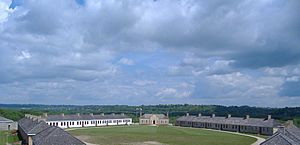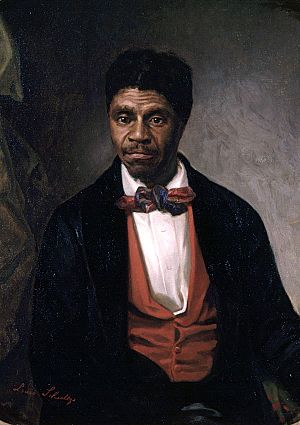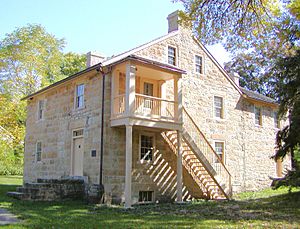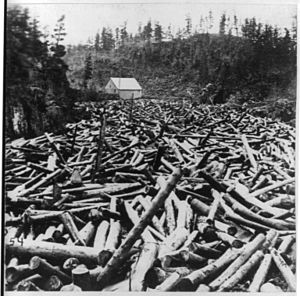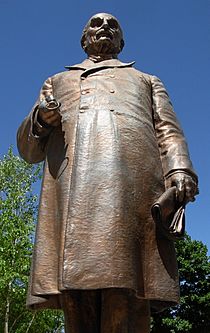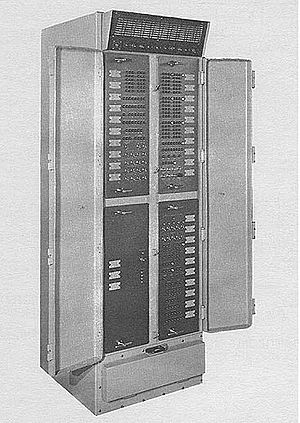History of Minnesota facts for kids
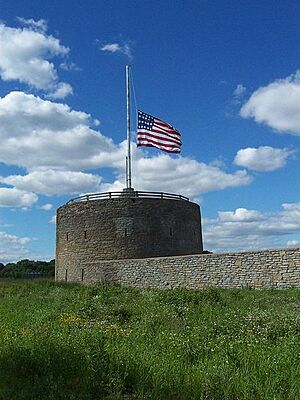
The history of Minnesota is shaped by its first people, the Native Americans. Later, European explorers and settlers arrived. Industries grew because of the state's natural resources. Minnesota became famous for fur trading, logging, and farming. Then, railroads and iron mining became important. Today, banking, computers, and health care are big parts of the state's economy.
The first known people in Minnesota followed large animals during the last ice age. They came before the Anishinaabe, the Dakota, and other Native American groups. French fur traders arrived in the 1600s. In the 1800s, Europeans moving west pushed out most Native Americans. Fort Snelling was built to protect U.S. lands and brought early settlers. These settlers used Saint Anthony Falls to power sawmills in the area that became Minneapolis. Others settled downriver in the area that became Saint Paul.
Minnesota officially became the Minnesota Territory in 1849. It became the 32nd U.S. state on May 11, 1858. After the American Civil War and the Dakota War of 1862, Minnesota's economy grew. Logging and farming used the state's natural resources. Railroads brought many immigrants, helped farms, and moved goods to markets. The power from St. Anthony Falls made Minneapolis grow. Its new milling methods made it the "milling capital of the world."
New industries came from iron ore found in the north. It was easy to dig up from open pits. The ore was shipped to Great Lakes steel mills from ports like Duluth and Two Harbors. As the economy grew, more people moved from farms to cities. The state government also became more involved. The Great Depression caused job losses in mining and problems between workers and bosses. But New Deal programs helped the state. After World War II, Minnesota became known for technology. Early computer companies like Sperry Rand, Control Data, and Cray helped this growth. The Twin Cities also became a center for arts. Places like the Guthrie Theater, Minnesota Orchestra, and the Walker Art Center opened.
Contents
Who Were Minnesota's First People?
The oldest human remains found in Minnesota are about 9,000 years old. They were found near Browns Valley in 1933. This person, called "Browns Valley Man," was found with tools from the Clovis and Folsom times. Some of the earliest signs of people living here for a long time come from a site near Mille Lacs Lake. It was used around 7500 BC. Later, large trading networks grew in the area.
Another early resident, "Minnesota Woman," was found in 1931 in Otter Tail County. Her bones are about 8,000 years old. She had a shell from Florida, showing that people traded over long distances.

Hundreds of years later, Minnesota's climate became much warmer. Large animals like mammoths died out. Native people changed what they ate. They gathered nuts, berries, and vegetables. They also hunted smaller animals like deer, bison, and birds. The stone tools from this time became smaller and more specialized. People also found new ways to catch fish, like hooks, nets, and harpoons. Around 5000 BC, people near Lake Superior started making metal tools. They pounded copper ore into shapes, heated it, and pounded it again to make sharp tools.
Evidence of Native American villages goes back to 3000 BC. The Jeffers Petroglyphs site in southwest Minnesota has carvings from this time. Around 700 BC, people started building burial mounds. This continued until Europeans arrived. At that time, there were 10,000 such mounds across the state.
By AD 800, wild rice became a main food in the region. Corn was grown farther south. Within a few hundred years, the Mississippian culture reached southeast Minnesota. Large villages were formed. The Dakota Native American culture may have come from some of these Mississippian peoples.
When Europeans first explored Minnesota, the Dakota tribes lived there. The Ojibwe (also called Chippewa or Anishinaabe) began moving west into the state around 1700. These tribes mainly hunted and gathered food. A small group of Ho-Chunk (Winnebago) Native Americans lived near Long Prairie. They later moved to a reservation in Blue Earth County in 1855.
How Did Europeans Explore Minnesota?
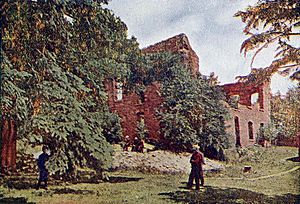
In the late 1650s, Pierre Esprit Radisson and Médard des Groseilliers were likely the first Europeans to meet Dakota Native Americans. They traveled along the southern shore of Lake Superior. The northern shore was explored in the 1660s. Claude-Jean Allouez, a missionary, made an early map of the area in 1671.
Around this time, the Ojibwa Native Americans reached Minnesota. They had moved west from the Maine area. They knew how to trade with Europeans and had guns. This caused problems between the Ojibwa and Dakota tribes.
In 1671, France signed a trade agreement with several tribes. Soon after, French trader Daniel Greysolon, Sieur du Lhut arrived. He traded with local tribes and explored the western Lake Superior area. He helped the Dakota and Ojibwa tribes make peace in 1679.
Father Louis Hennepin and his friends were captured by a Dakota tribe in 1680. While with the tribe, they found and named the Falls of Saint Anthony. Du Lhut later helped Hennepin's group get released. Hennepin wrote a book about his travels in 1683. He made some parts, like the description of Saint Anthony Falls, sound much grander than they were. For example, he said the falls were 50 or 60 feet high, but they were only about 16 feet.
Pierre-Charles Le Sueur explored the Minnesota River around 1700. He thought blue earth in the area was copper, but it was not.
Explorers looking for the famous Northwest Passage and large inland seas kept passing through Minnesota. In 1721, the French built Fort Beauharnois on Lake Pepin. In 1731, Pierre La Vérendrye was the first European to travel the Grand Portage trail. He used a map drawn on birch bark by his guide, Ochagach. The North West Company, a fur trading company, was set up along the Grand Portage in 1783–1784.
Jonathan Carver, a shoemaker, visited in 1767. He wrote journals about his trip. Carver County and Carver's Cave are named after him.
Until 1818, the Red River Valley was considered British land. The border was not marked until 1823 by Stephen Harriman Long. Many settlers from the Red River Colony moved into the United States through this valley in the 1820s. The area had been home to Métis people, who were children of European traders and Native Americans.
Several people tried to find the source of the Mississippi River. The true source was found in 1832 by Henry Schoolcraft. He was guided by Ojibwa people to a lake he named Lake Itasca. Other explorers included Zebulon Pike in 1806 and Joseph Nicollet in the late 1830s. Nicollet mapped the Upper Mississippi River basin. He and John C. Frémont carved their names in the pipestone quarries near Winnewissa Falls. This area is now Pipestone National Monument.
Henry Wadsworth Longfellow never visited Minnesota. But his poem, The Song of Hiawatha (1855), made the state popular. The story was based on Ojibwa legends.
How Did Minnesota Become a Territory and a State?
Getting the Land for Minnesota

The United States gained all land east of the Mississippi River in 1783 after the American Revolution. This included parts of what would become Minnesota. Most of the state was bought from France in 1803 as part of the Louisiana Purchase. The exact border with British North America was set in 1818 at the 49th parallel. Border disputes east of the Lake of the Woods ended with the Webster–Ashburton Treaty of 1842.
Before becoming a territory, parts of Minnesota belonged to other U.S. territories. The northeastern part was in the Northwest Territory, then Illinois Territory, then Michigan Territory, and finally Wisconsin Territory. The western and southern areas became part of the Iowa Territory in 1838.
Fort Snelling and the Start of Minneapolis and Saint Paul
Fort Snelling was the first big U.S. military base in Minnesota. The land for the fort was bought in 1805 by Zebulon Pike. Building started in 1819 to protect fur trade interests. It was finished in 1825. One goal of the fort was to help solve problems between the Ojibwe and Dakota tribes.
In the 1850s, Fort Snelling was important in the famous Dred Scott court case. Dred Scott and his wife, who were enslaved, lived at the fort with their owner. They argued that because they lived in free territory, they should no longer be enslaved. The U.S. Supreme Court decided against them.
By 1851, treaties with Native American tribes opened much of Minnesota for settlement. Fort Snelling was no longer a frontier outpost. It became a training center for soldiers during the American Civil War. Today, it is a historic site run by the Minnesota Historical Society.
Fort Snelling helped create Minneapolis. Soldiers built roads, farmed, and built mills at Saint Anthony Falls. Franklin Steele, a businessman, built the first private sawmill there in 1848. The community of Saint Anthony grew around it. Later, John H. Stevens built the first house in Minneapolis on the west side of the falls in 1850. In 1854, Stevens planned the city of Minneapolis. In 1872, Minneapolis and Saint Anthony joined together.
Saint Paul, Minnesota also started because of Fort Snelling. People who had settled near the fort were asked to move. They settled downriver. Pierre Parrant, a popular moonshiner, opened a saloon there. The settlement was first called "Pig's Eye" after him. It was later changed to Lambert's Landing and then Saint Paul. The Native American name for the area was Im-in-i-ja Ska, meaning "White Rock."
Minneapolis and Saint Paul are known as the "Twin Cities." They had a rivalry early on. Saint Paul was the capital, and Minneapolis grew through industry. The term "Twin Cities" was first used around 1872. Today, Minneapolis is the largest city in Minnesota, and Saint Paul is the second largest.
Early European Settlements and Growth
Henry Hastings Sibley built the first stone house in the Minnesota Territory in Mendota in 1838. Other stone buildings were used by the American Fur Company to buy animal furs.
Logging was another early industry. Loggers valued the white pine, which was common in northeast Minnesota and the St. Croix River valley. Before railroads, logs were floated down rivers to market. Towns like Marine on St. Croix and Stillwater became important logging centers. Uncontrolled logging and drought caused big fires. The Great Hinckley Fire in 1894 burned a large area and killed over 400 people. More fires happened in 1910 and 1918.
Saint Anthony, on the east bank of the Mississippi River, was a major lumber milling center. Franklin Steele built the first private sawmill at Saint Anthony Falls in 1848. The oldest house still standing in Saint Anthony is the Ard Godfrey house, built in 1848.
Minnesota Becomes a Territory
Stephen A. Douglas, a U.S. Senator, wrote the bill to create the Minnesota Territory. He wanted the upper Mississippi valley to grow. He made sure that Fort Snelling and Saint Anthony Falls were included. The Minnesota Territory was created on March 3, 1849. It stretched far into what is now North and South Dakota.
Alexander Ramsey was the first governor of Minnesota Territory. Henry Hastings Sibley was the territorial delegate to Congress. The populations of Saint Paul and Saint Anthony grew quickly. Henry Mower Rice, who replaced Sibley, worked to help Minnesota in Congress. He pushed for a railroad connecting Saint Paul to Lake Superior.
Achieving Statehood
In December 1856, Rice proposed two bills in Congress. One would let Minnesota create a state constitution. The other was for a railroad land grant. Rice's bill defined a state with both prairie and forest lands. The state's borders were set.
At this time, tensions were rising between the northern and southern U.S. states. This led to the American Civil War. Northerners wanted Minnesota to become a free state. Southerners worried about losing power. Many senators argued that Minnesota's population was too small for statehood. But the bill passed on February 26, 1857.
After the bill passed, Minnesota's lawmakers had trouble writing a state constitution. Republicans and Democrats were very divided. They even wrote two separate constitutions. Eventually, they worked together to create one common constitution. But the two groups still refused to sign the same document. So, one copy was signed by Republicans, and another by Democrats. Voters approved the constitution on October 13, 1857.
The state constitution was sent to Congress in December 1857. Approval was delayed for months because of debates over slavery. Finally, the bill passed. The eastern half of the Minnesota Territory became the 32nd U.S. state on May 11, 1858. The western part later became part of the Dakota Territory.
What Happened During the Civil War and Dakota War?
Minnesota strongly supported the Union during the Civil War. About 22,000 Minnesotans served. The 1st Minnesota Volunteer Infantry was very important at the Battle of Gettysburg. Governor Alexander Ramsey was the first state governor to offer help to President Lincoln.
At the same time, Minnesota faced another crisis: the Dakota War of 1862. The Dakota people had signed treaties in 1851. They were worried about starving because they had lost hunting lands. They were given land along the Minnesota River, but later forced to sell half of it. In 1862, crops failed, and government money was delayed. After some young Dakota men killed a white settler family, the Dakota leaders decided to continue attacks to drive out settlers.
Over several days, Dakota attacks killed hundreds of white settlers and government workers. This caused panic. State and federal forces fought back. Battles happened at Fort Ridgely, Birch Coulee, and Wood Lake. The war lasted six weeks. Afterward, 425 Native Americans were put on trial. Of these, 303 were sentenced to death.
Bishop Henry Benjamin Whipple asked President Abraham Lincoln for mercy. The death sentences for all but 39 men were changed to prison terms. On December 26, 1862, 38 men were hanged at Mankato. This was the largest mass execution in U.S. history. Many other Dakota people, including those who did not fight, were held in a prison camp. More than 300 died from disease. Survivors were later sent to reservations outside Minnesota.
A small number of Dakota Native Americans returned to Minnesota in the 1880s. They formed communities near Granite Falls and Red Wing. However, most Dakota people were not allowed to live in Minnesota after this time.
How Did Minnesota Grow Economically and Socially?
Farming and Railroads
After the Civil War, Minnesota became a popular place for European immigrants to settle and farm. Minnesota's population tripled between 1870 and 1890. The Homestead Act of 1862 made it easy for settlers to claim cheap, fertile land. Railroad companies like the Northern Pacific Railway advertised opportunities in Minnesota. They helped immigrants move to the state.
James J. Hill was key in expanding the Saint Paul and Pacific Railroad. He built lines from Minneapolis-Saint Paul into the Red River Valley. He also built the Stone Arch Bridge in Minneapolis in 1883. By 1890, his railroad, now the Great Northern Railway, reached Seattle. Other railroads also helped Minnesota grow.

Oliver Hudson Kelley helped farmers by co-founding the National Grange. This group helped farmers learn new methods and speak up about their concerns. One big concern was the high prices charged by railroads and grain elevators. Since there was little competition, railroads could charge a lot. In 1871, Minnesota started regulating railroad rates.
Saint Anthony Falls was very important for Minneapolis. Its power first ran sawmills, then flour mills. By 1900, Minnesota mills ground 14.1% of the nation's grain. New technology, like the middlings purifier and roller mills, helped Minneapolis mills make high-quality "patent" flour. Companies like Pillsbury and Washburn-Crosby (now General Mills) became leaders. This milling success brought many people and money to Minnesota.
Industrial Growth

At the end of the 1800s, new industries shaped Minnesota. In 1882, a hydroelectric power plant was built at Saint Anthony Falls. This was one of the first in the U.S. Iron mining began in northern Minnesota with the Soudan Mine in 1884. The Vermilion Range was explored. Another mining town, Ely, started in 1888.
Soon after, the Mesabi Range was found. Its ore was close to the surface, making it easy to dig up. By 1904, there were 111 open-pit mines on the Mesabi Range. Railroads like the Duluth, Missabe and Iron Range Railway were built to ship the ore to Two Harbors and Duluth. Large docks loaded the ore onto ships for transport across the Great Lakes. The mining industry helped Duluth grow into a big city. In 1904, iron was also found in the Cuyuna Range. This ore also had manganese, which made it more valuable.
Mayo Clinic: A Medical Pioneer
Dr. William Worrall Mayo came to the U.S. in 1846 and became a doctor. In 1863, he moved to Rochester. In 1883, a powerful tornado hit Rochester, causing many deaths and injuries. Dr. Mayo worked with nuns from the Sisters of St. Francis to treat survivors. After the disaster, they saw the need for a hospital. They built the 27-bed Saint Marys Hospital, which opened in 1889.
This hospital became part of the Mayo Clinic. It grew from the practice of Dr. Mayo and his sons, William James Mayo and Charles Horace Mayo. Dr. Henry Stanley Plummer joined them in 1901. Plummer created many systems for group medical practice, like a single medical record for each patient.
Cities Grow and Government Changes
As industries grew, more people moved to cities. By 1900, the Twin Cities were major business centers. Wealthy businessmen from railroads, milling, and logging lived there. They donated money for cultural places like the Minneapolis Symphony Orchestra (now the Minnesota Orchestra). The parks of Minneapolis became famous. The new Minnesota State Capitol building and the Cathedral of Saint Paul also drew attention.
The government's role also grew in the early 1900s. As large companies made goods, people asked the government for protection. They wanted inspections of food and medicines. They also wanted rules for public services like electricity. The growth of cars led to calls for better roads and traffic laws. Minnesota started its main highway system in 1920. New rules were needed for banking and insurance. Worker safety also became a concern, leading to workers' compensation systems. As government became more complex, citizens became more involved in politics.
The Great Depression in Minnesota
Wilbur Foshay, a utility company owner, built the Foshay Tower in 1929. It was Minnesota's tallest building at the time. But when the Wall Street Crash of 1929 happened, Foshay lost his money. The tower became a symbol of the wealth that disappeared.
The Great Depression affected Minnesota in several ways. There were job losses on the Iron Range and a drought in the Great Plains. One reason for the Depression was that businesses in the 1920s became very efficient. But they did not share their profits with workers or lower prices. So, people could not afford to buy the goods factories made.
Floyd B. Olson of the Minnesota Farmer-Labor Party became governor in 1930. He signed a bill for $15 million for highway construction to create jobs. He also set a minimum wage. By 1932, his party proposed a state income tax, taxes on chain stores, low-interest farm loans, and unemployment insurance. The 1933 legislative session passed many laws to help with the Depression. These included stopping mortgage foreclosures, lowering property taxes, and creating an old-age pension system.
Labor unions became more active. The Minneapolis Teamsters Strike of 1934 was a major event. As a result of this and other strikes, Congress passed the National Labor Relations Act in 1935. Government programs like the Civilian Conservation Corps and Works Progress Administration brought much-needed work projects to Minnesota. The Indian Reorganization Act in 1934 gave Minnesota's Ojibwa and Dakota tribes more control over their own affairs.
What is Modern Minnesota Like?
Arts and Culture Flourish
The Minneapolis Institute of Arts opened in 1883. Its current building opened in 1915. The Minnesota Orchestra started in 1903 as the Minneapolis Symphony Orchestra. It moved into its own building, Orchestra Hall, in 1974. The building has a modern look and excellent sound. The Saint Paul Chamber Orchestra also became a professional orchestra.
The Walker Art Center opened in 1927. In the 1940s, it started focusing on modern art. It has works by famous artists like Pablo Picasso. The Guthrie Theater opened in 1963. Its founder, Sir Tyrone Guthrie, wanted a regional theater that was not limited by Broadway's commercial rules. This theater became a model for other non-profit theaters.
Minnesota in World War II
Minnesota helped a lot in World War II. The United States Navy hired Cargill to build ships. Cargill built 18 refueling ships and four towboats. After the war, Cargill's facilities became a major grain shipping terminal. Honeywell built airplane control systems and periscope sights. The U.S. government built the Twin Cities Ordnance Plant to make munitions. It employed 8,500 workers. More than half were women because many men were fighting. The plant also hired African American and Native American workers.
Camp Savage was a school in Savage, Minnesota. It trained Japanese-American soldiers in foreign languages and military intelligence. The school later moved to Fort Snelling. Fort Snelling itself was a major center for new recruits. Over 300,000 recruits were processed there during the war.
Modern Economy and Technology
Farming changed a lot after World War II. Technology increased farm productivity. Automation, machine milking, and large chicken farms became common. Planting became more specialized with new types of corn and wheat. Tractors and combines became standard. University of Minnesota professor Norman Borlaug contributed to this knowledge. Large canneries like the Minnesota Valley Canning Company used Minnesota's productive farmland.
The Minnesota Mining and Manufacturing Company (3M) was founded in 1902. It started by making sandpaper. Under William L. McKnight, the company developed many products like masking tape, adhesives, and films.
Suburban areas grew rapidly after the war. In 1957, a planning commission was created for the Twin Cities area. This became the Metropolitan Council in 1967.
Northwest Airlines was founded in 1926. It was the main airline at Minneapolis-Saint Paul International Airport. It merged with Delta Air Lines in 2008.
Minnesota: A Digital State
Minnesota became a center for technology after the war, especially in the computer industry. Engineering Research Associates was formed in 1946 to build computers. It later merged with Remington Rand and became Sperry Rand. William Norris left Sperry in 1957 to start Control Data Corporation (CDC). Seymour Cray left CDC to form Cray Research, known for supercomputers.
Medical device maker Medtronic was also founded in the Twin Cities in 1949. Honeywell was a national player until 1999. IBM also had a large manufacturing site in Rochester starting in 1956. The state government and politicians like Hubert Humphrey helped create a good environment for technology. The University of Minnesota trained many computer specialists who stayed in the state. By the 1960s, Minnesota became an early leader in technology, similar to Silicon Valley.
Images for kids
-
Mass hanging in Mankato, Minnesota.
-
Duluth, Missabe and Iron Range Railway ore docks loading ships, around 1900–1915.
See also
 In Spanish: Historia de Minnesota para niños
In Spanish: Historia de Minnesota para niños



